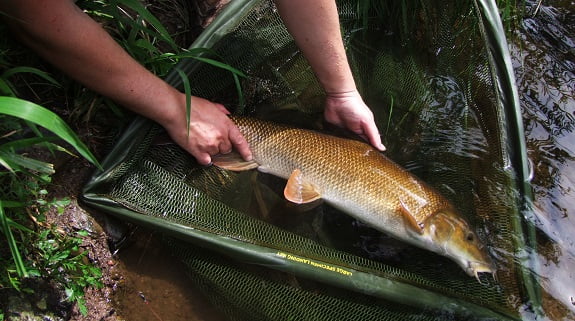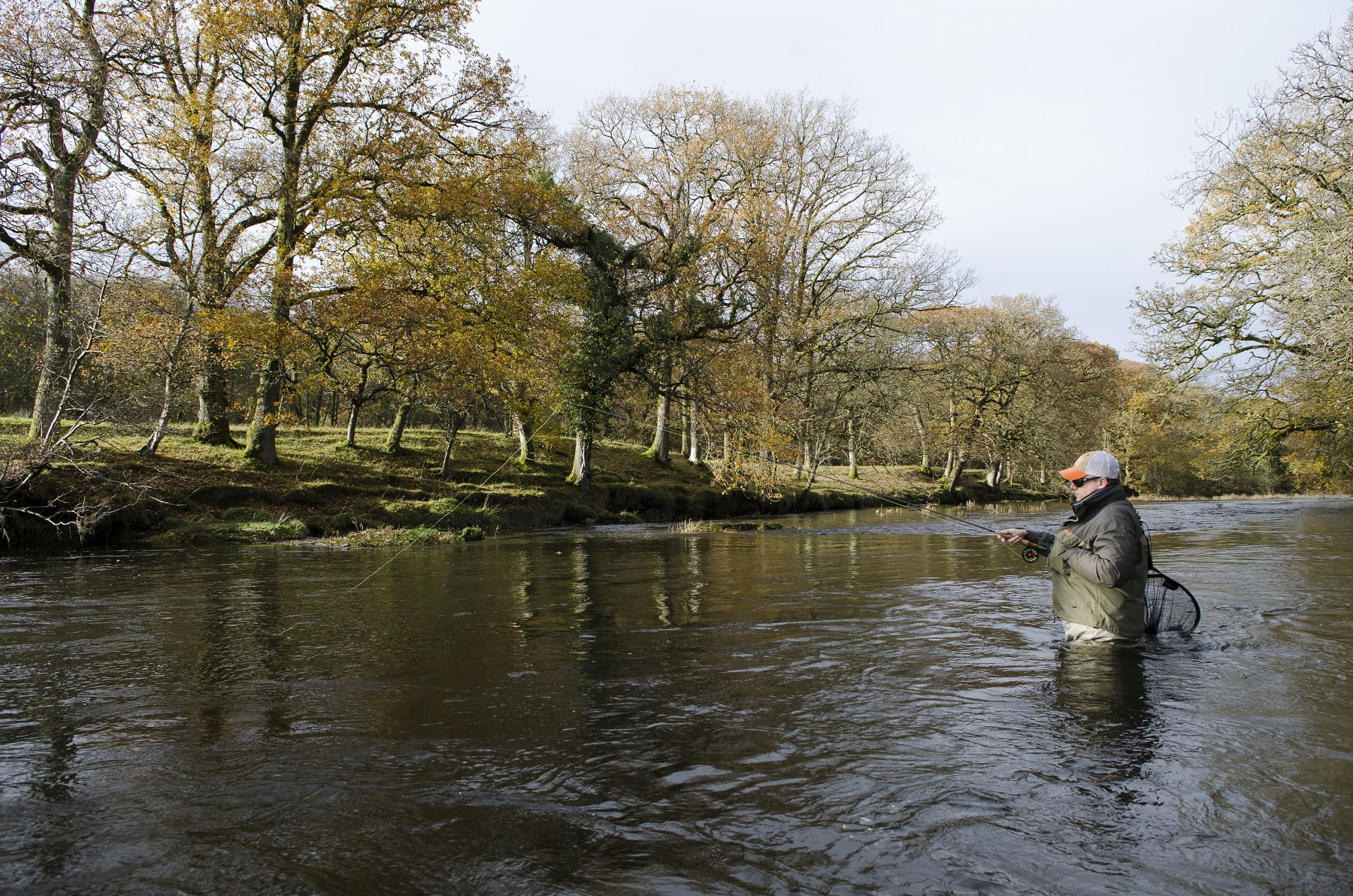A Beginners Guide to Fishcare
Releasing your quarry unharmed is one of the most important things any angler can learn. Angling Trust content creator Dominic Garnett shares essential tips to help you safely catch and release your fish so that they’re ready to do battle another day!

If a fish has fought hard, you may need to support it in the water until it gets its breath back – Image Adam Fisher
While it’s great to learn all about rigs, methods and tactics for big fish, one of the most important aspects of modern angling is one of the least written about. Handling and releasing your catch safely should be one of the first things an angler learns; sadly it’s not always the case.
Why do we release fish in the first place? It’s simple. To preserve our sport. If we took our catch home every time we went fishing, we would soon run out. That’s the reality of living on a small island country with lots of anglers and only so many fish to catch! A fish that is dead cannot give another angler pleasure. It cannot grow bigger or, crucially, breed and produce more fish. Furthermore, there is a deep satisfaction in returning a fish safely, knowing it will live to fight not just another day, but possibly many years.
Preparation and essential equipment
Besides the right gear, good fish care is all about anticipation and being prepared. Do you know where your forceps or scales are at a moment’s notice? Is your tackle strong enough, and have you earmarked a safe place to land a fish in advance?
Having the right gear is another must. Two of the most commonly neglected pieces of equipment are the correct unhooking tools (a pair of pliers is no good) and the right landing net (a generous sized net of soft mesh). A large, quality landing net also doubles as a good investment for retaining fish in the water for short periods. Last but not least, nobody fishing for carp, pike or other larger species should be without an unhooking mat – and many clubs and fisheries won’t let you fish without one.
Many anglers also debarb hooks or use barbless patterns these days too. In 90% of situations, barbless is best. The possible exception is with large fish, the argument being that a barbless can move around and cut more during a long fight. In this situation, I believe a “bumped” hook is best (i.e. one where the profile of the barb has been reduced by pliers, but there is still a slight “bump”). This stops the hook moving around during the fight, but can still be removed without any tearing.

The right way to pose for a quick picture; low to the ground and with a mat underneath. Image: Dom Garnett
When it comes to safely handling and releasing fish, there are a few golden rules. Advance knowledge and preparation are key here; the time to wonder about best practice is not when a fish is kicking on the bank! Here are some of the universal rules of responsible catch and release angling:
Always handle fish with wet hands: This avoids removing their protective slime. NEVER use a towel. You will notice fish behave much better if you have wet hands (think about it – they have come from somewhere cold and wet, while your paws are dry and warm!)
Always have the right tools: You should never fish without the means to extract a hook. For small fish, a disgorger is the answer and for larger species, forceps are better. If you fish for pike, these should be a minimum of 12” long. Buy quality and always pack a spare set (they are easy to lose on the bank and lots of companies make the damned things green or dull coloured!)
Use sensible tackle: A totally knackered fish is a fish in danger. Try not to play your quarry to exhaustion but be as quick as reasonably possible. Large fish like carp, pike and barbel need strong gear. If the fish has fought like fury, you could give it a few seconds to rest in the water before you handle it.
Handle fish carefully and as little as possible: The less faff the better here. The more handling, the more slime you remove and the more risk.
Be prepared: Have your unhooking equipment, camera and other essentials ready and close to hand at all times.
Keep time out of water to a minimum: If you want to weigh a fish or take a picture, you can always keep it immersed using your landing net (or perhaps in a carp sack briefly) while you set up the shot and zero your scales. Avoid keeping your catch out of water for more than is absolutely necessary.

Keep fish wet for as long as possible. Image source: Tim Hughes
Use the right net: Landing nets are often essential for all but the smallest fish. Avoid small nets and harsh mesh materials (modern rubberized mesh is excellent). A large net can also be used to briefly retain your catch in the water to let it recover or give it a breather if you want to take a picture.
Never stand up or walk around while holding a big fish: A fish dropped from standing height is often a dead one; it may swim off, but you will have damaged its internal organs. Instead, kneel with it over the mat or the water for safety. And use your net to carry fish back to the water, lowering gently back.
Handle with care (cradle, don’t clench): A fish is a living thing, not a bragging item. Hold it as you would a little baby, not some macho trophy. If it’s really heavy, supporting closer to your body is safer than thrusting out to the camera. Try to “cradle” a large fish, and avoid clenching or squeezing around the throat area because this is where many of the vital organs are.
Weigh safely and keep your catch wet: The easiest way to weigh a fish is in the net, and then deduct the weight of your net later. Make sure the fish is lying “flush” (i.e. evenly in the bottom of the net with no fins trapped) before lifting the scales. Specimen hunters often prefer a sling. If you use one of these, make sure it’s well doused with water.
Lower, don’t drop: Although non-anglers will ask if you’re going to “throw” it back, this is not something a caring angler would ever do. Every fish should be lowered back into the water if humanly possible. If the spot is awkward and this is impossible, use your net to lower the fish back safely.
Support if necessary: Sometimes fish will swim off strongly right away. Other times they may be tired and need some help. If a fish has battled hard, never just let go of it right away. Hold it upright in the water for a few seconds to let it recover (this could be a few minutes for some fish).
First aid for fish: Last but not least, some anglers go even further with fish care, especially for carp, by applying a little first aid. Products such as Klinik can disinfect any nicks from hooks or scale damage, assisting recovery. Gel-based products are the most effective, as they stick to the target.
Another tip for those who need to retain a net of small to medium fish for photography is to use a little clove oil mixed with water and douse the fish; it is a natural aesthetic and calms them down. In fact, Environment Agency staff have been known to use it in fish surveys to de-stress fish.
Pike and other special cases…

The right way to do it: cradle and support your catch, avoid dry hands or clenching at the throat. Image source: Adam Fisher
Another important point to make in our guide is that not all fish are created as tough as each other. Carp, the most cared for of the lot, are tough as old boots (obviously this is still no reason not to treat them with total respect!)
Grayling, trout and others can be very brittle though, and need extra care. Pike are perhaps the most misunderstood and fragile fish of all, in spite of their fierce appearances. For a thorough guide to pike unhooking and handling, it’s well worth checking out the Pike Angler’s Club’s code of safe practice.
What about sea fish and stocked trout?
While coarse anglers are very much at the forefront of catch and release, a lot of sea and game anglers are now just as passionate about fish welfare. Indeed, if you’re not going to eat it, why on earth wouldn’t you want it to go back unharmed?
Most coarse fish, and indeed many wild game fish, are protected by law these days and removing them is a criminal offence. However, with some stocked trout, as well as sea fish above a set of minimum size limits, you may choose (or be obliged) to take the fish.
We would strongly advise returning slow-growing and precious fish such as sea trout and bass, even if you may legally take them. In the case of Salmon in Wales But if you must kill, do it quickly and humanely – a “priest” is the tool to do it, with a short sharp blow to the skull on the top of the head.
How else can we make sure fish go back safely?
Feelings can run quite high when it comes to catch and release practice these days. Facebook pictures of fish handled with towels or without an unhooking mat in sight quickly attract a barrage of critical and angry comments.
While we all want to see responsible fishing, there should be no place for abuse. We can learn from each other and often those targeted by angry comments on social media are just inexperienced, rather than deliberately cruel. Don’t immediately castigate those who show poor practice – the last way to make anyone listen and learn is to start a fight with them. Be helpful and friendly, and remember you were once inexperienced too.
There are of course other cases where anglers know the rules but are still negligent or even criminal – and we can and should help to protect our waters. On the vast majority of coarse fisheries, taking fish is illegal and you should report any poachers or law-breakers to the NRW Wales hotline. The number is 0300 065 3000 – have it stored on your phone!
We all have a part to play in protecting the sport. It might seem ironic, but the folks who want to stick a hook in fish are usually also their greatest protectors. We will inevitably cause fish some brief stress, but with modern barbless hooks and careful handling, virtually every fish we catch will swim off happily and continue to thrive. I should know. There are several times when I’ve re-captured the same fish years later, bigger and in rude health. What a great feeling!
About the author: Weekly Angling Times columnist, Dom Garnett is also a fishing guide and author of several books, including the Amazon Bestseller Flyfishing for Coarse Fish, Canal Fishing and his recent book of angling tales Crooked Lines. Read more at: www.dgfishing.co.uk



